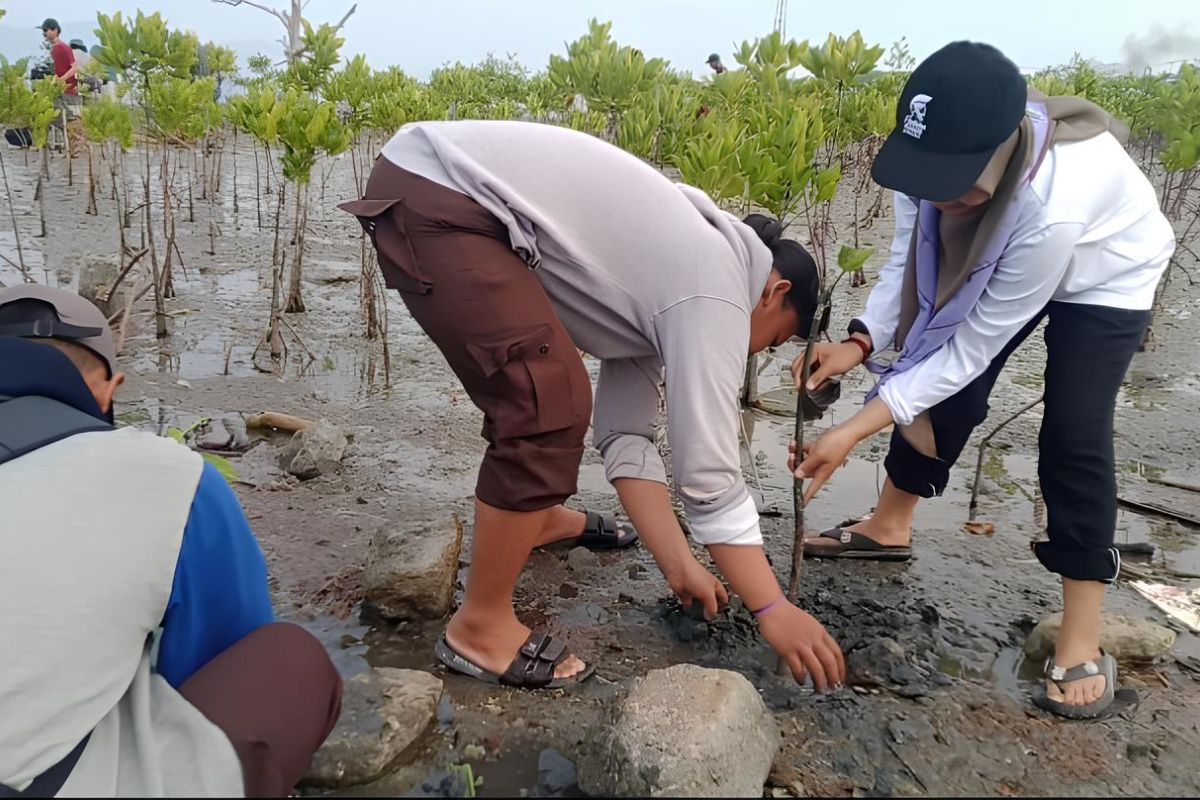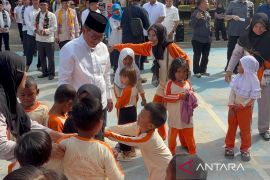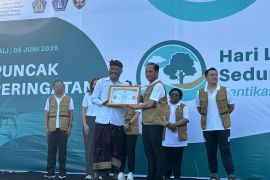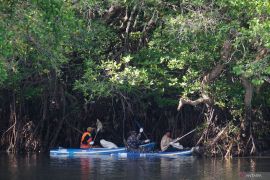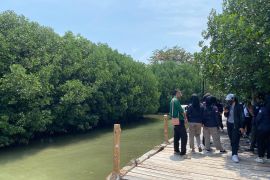For Indonesia, as the ASEAN chair this year, development of the blue economy deserves to receive attention, as oceans constitute three-quarters of its territory.
The Ministry of National Development Planning is targeting the blue economy sector to contribute up to 15 percent to the gross domestic product (GDP) in 2045 or to increase by around three folds the current figure of 5.3 percent.
To this end, the government is currently striving to develop seven aspects of the blue economy, namely capture and aquaculture fisheries, maritime-based industry, shipbuilding, ecotourism, marine transportation services, biotechnology, and bioeconomy, as well as research and development of marine resources.
However, the development of various blue economy potentials is often solely focused on managing marine resources, although coastal area resources also need to be optimized, for instance, beaches and mangrove forests.
Deputy for Maritime Affairs and Natural Resources at the Ministry of National Development Planning, Vivi Yulaswati, stated that the development of mangrove ecosystems is currently a hot topic of conversation, as they can absorb around 21.9 billion tons of CO2 emissions in Indonesia.
Various countries in subtropical zones that cannot plant mangroves conduct carbon trading by planting mangroves in Indonesia.
The important effort to be made now is to conserve the ecosystems and not to plant new trees or rehabilitate damaged mangrove forests. It is because what serves as a carbon sink or absorber of carbon emissions is the clay in the ecosystem and not the mangrove trees themselves.
Mangrove areas also have the potential to become tourist destinations, such as the 700-year-old mangrove forest in the Belitong UNESCO Global Geopark, Bangka Belitung Islands, and the mangrove ecosystem in the Raja Ampat UNESCO Global Geopark, West Papua.
Regarding mangrove areas, an environmental observer from the United Nations Development Programme (UNDP) Indonesia, Muhammad Yayat Afianto, stated that apart from being a carbon sink and tourist attraction, mangrove forests have vast potential for fisheries, creative economy, and biotechnology.
Hence, the government's efforts to implement the Indonesian Blue Economy Roadmap 2023-2045, which was released last July and includes efforts to develop the potential of coastal fisheries and mangrove ecosystems, can reduce poverty and hunger rates.
The roadmap is also expected to be able to improve the environment for more than 75 million Indonesians and open up 45 million new job opportunities.
Related news: Digital mangrove planting becomes strategy for developing blue economy
Resilience
The Indonesian Institute of Sciences (LIPI) recorded that the area of mangrove forests in Indonesia reached 3.3 million hectares in 2021, which covers 22.6 percent of the world's mangroves, making the country home to the largest mangrove ecosystem in the world.
The level of diversity of mangrove species and their associated plants in Indonesia is quite high, as there are 49 types of mangrove species and 155 species of associated plants in the country.
The mangrove ecosystems become habitats, spawning grounds, and nursery and feeding grounds for various species of fish, crustaceans, and mollusks.
They also serve as a place for nesting, foraging, and breeding for several types of birds and reptiles.
Hence, development of the blue economy in mangrove areas needs to prioritize the preservation of the ecosystem, use sustainable financing, and actively involve local communities, so that the planned programs can be implemented well.
Preservation of the ecosystem is an important aspect that should receive attention because in the event of damage to the mangrove area, the resilience of the ecosystem and surrounding biota will also be disrupted.
This will pose threats to the development of marine resource potentials to improve Indonesia's blue economy, especially in the sectors of capture and cultivation fisheries, marine-based industry, biotechnology, bioprospecting, and bioeconomy.
If not handled well, the damage to mangrove forests, which serve as habitats for various living species, will cause diversity loss.
Various marine biota are important resources in capture and aquaculture fisheries.
Based on data from the Ministry of Maritime Affairs and Fisheries (KKP), the production of capture fisheries reached 7.99 million tons in 2022, while the production of aquaculture fisheries reached 16.87 million tons in the same year.
Meanwhile, crustaceans are the main source of chitosan, a substance that is now widely sought after as a superfood, medicine, and cosmetic ingredient.
The shells of crustaceans, especially shrimp, can also be developed to make coating materials for anti-radar fighter aircraft.
The damage in mangrove areas that can affect the ecosystems around them, such as coral reefs and seagrass meadows, can indubitably hamper the development of Indonesia's blue economy potential.
Seagrass meadows, in addition to seagrasses, have the potential to be developed to become biofuel sources.
Korea and Japan, which currently tend to develop their energy sectors towards biofuels, are showing interest in Indonesian seaweed and seagrass.
Related news: Govt to push seagrass, mangrove preservation to boost blue carbon
Game changer
The increasingly worrisome environmental conditions due to global warming have prompted world leaders to adopt 17 Sustainable Development Goals (SDGs), with a target of achieving them by 2030.
Efforts to realize the achievement of SDGs still need to be maximized.
Currently, the Earth and its inhabitants are facing the challenge of environmental sustainability that is increasingly more complex, namely the triple planetary crisis comprising climate change, pollution, and biodiversity loss.
In the maritime sector, global warming has caused climate change and rising sea levels, drowning many coastal areas, such as several villages in the northern part of Java Island.
Pollution, especially due to industrial or plastic waste that turn into microplastics in the oceans, is also causal to the death of aquatic biota.
These cause biodiversity loss, which has also been made worse by human activities due to the lack of information and education.
National Development Planning Minister Suharso Monoarfa once stated that one of the causes behind the loss of the mangrove ecosystem in Gili Trawangan, one of the tourist destinations in West Nusa Tenggara, is the lack of understanding among members of the community regarding the importance of mangroves.
Members of the local community said they were unaware that the plants were mangroves, as they were accustomed to calling them by a local name and thought that they were just ordinary trees, so they used them to make huts.
In fact, mangroves, apart from serving as a pillar of ecosystem resilience whose potential can be explored to increase the value of the national blue economy, are also helpful for preventing abrasion and flooding in coastal areas.
To this end, the Ministry of National Development Planning is currently formulating the 2025-2029 National Medium-Term Development Plan to accelerate the achievement of SDGs, especially Goal 14 on life below water.
Implementation of the goal is aimed at preserving and sustainably utilizing marine and ocean resources for sustainable development.
Blue economy is, indeed, one of the game changers in the development plan because by tackling the existing challenges and continuously developing the blue economy, Goal 14 of SDGs can be achieved.
Of course, to make the blue economy effective as a game changer in achieving the goal and maintaining environmental sustainability, cooperation from various parties, including the government, the community, academicians, the private sector, and the media, is needed to carry out the programs that have been established.
Intensifying the dissemination of education that apart from the oceans, coastal areas and mangrove forests also play an important role in developing the blue economy is essential to hopefully prevent any parties from damaging mangrove ecosystems.
Related news: AIS Forum states keen to adopt blue economy: KKP Ministry
Editor: Yuni Arisandy Sinaga
Copyright © ANTARA 2023
